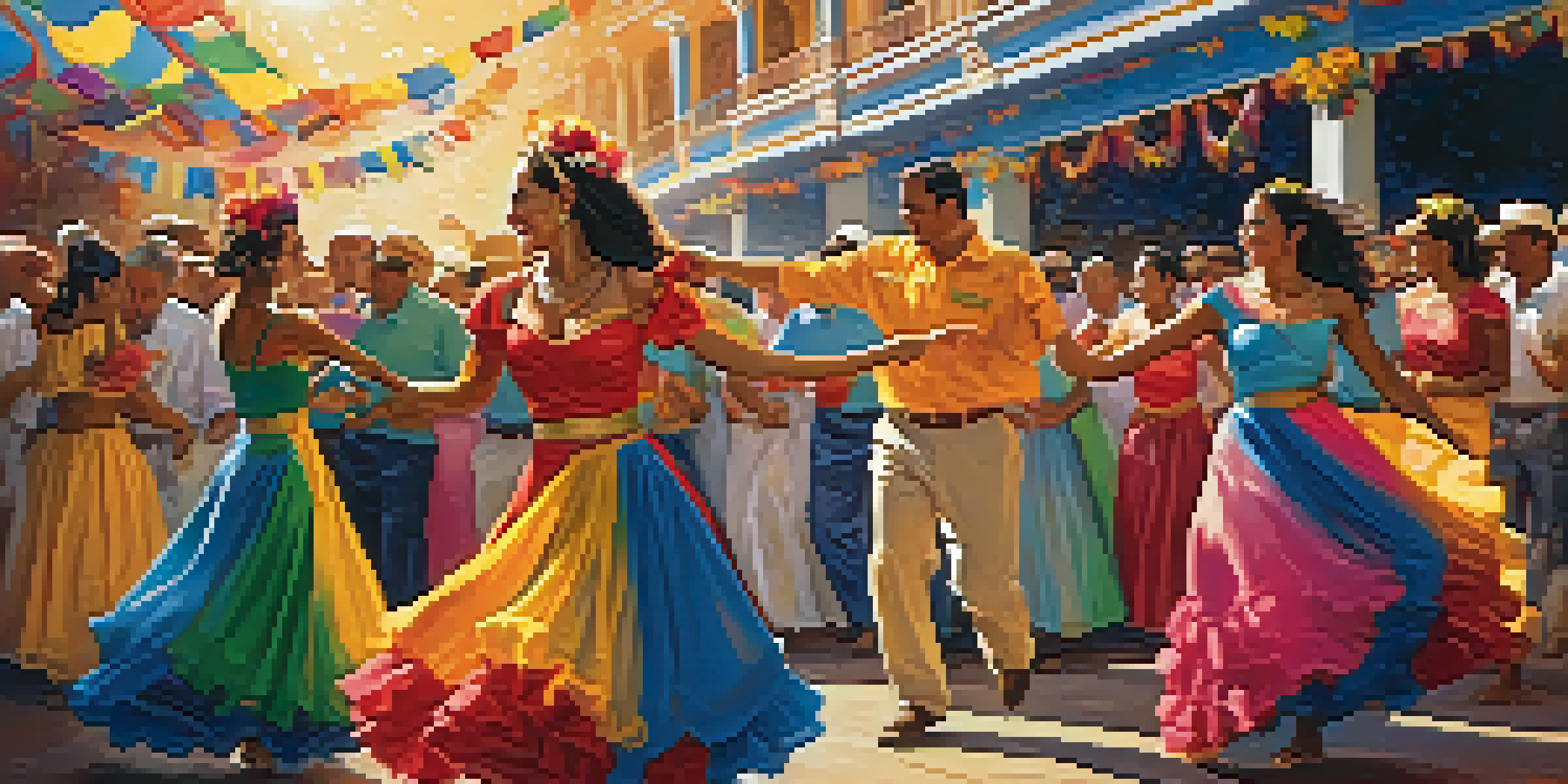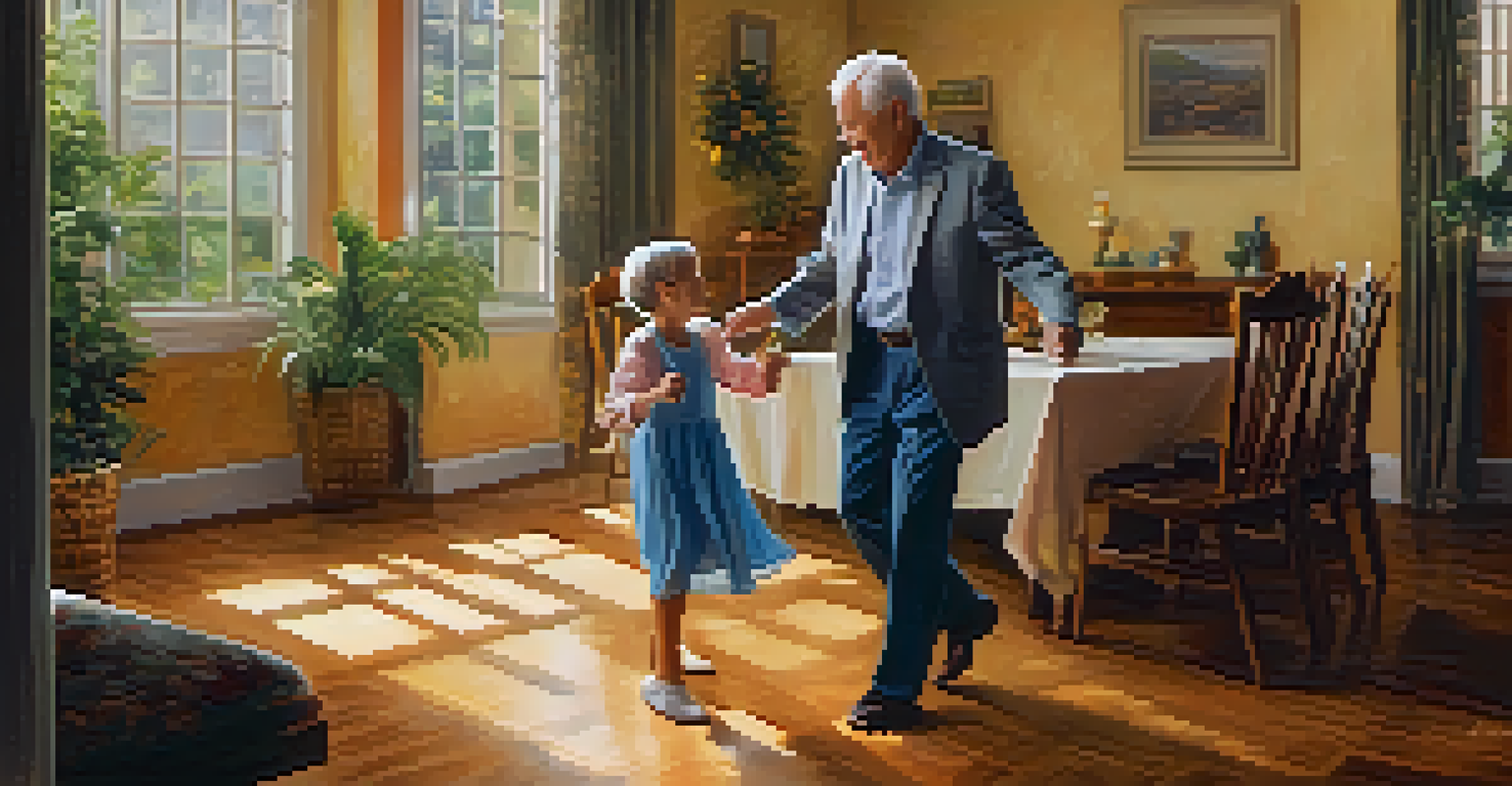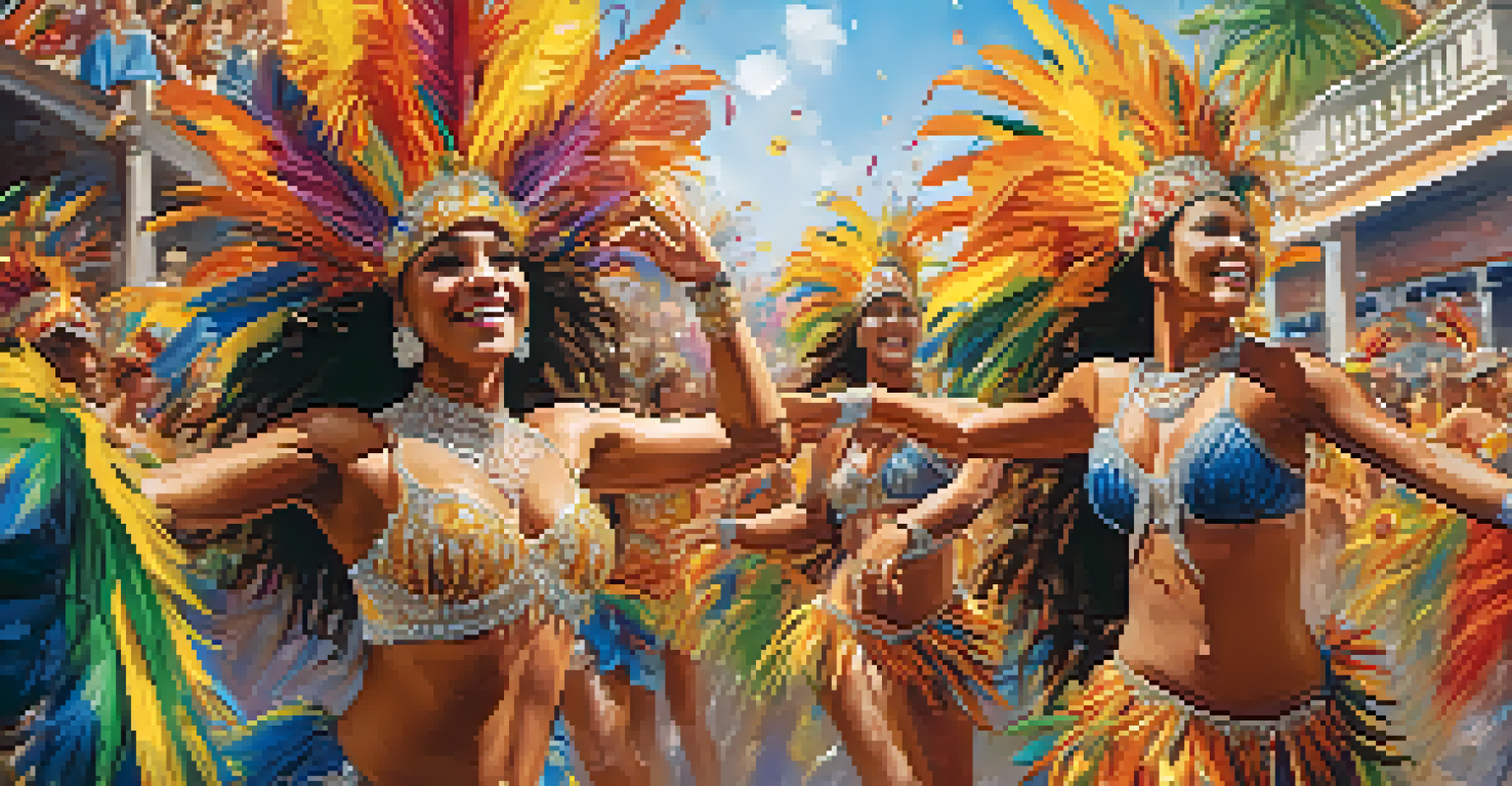Role of Dance in Celebrating Latin American Festivals

Dance as Cultural Expression in Latin American Festivals
Dance in Latin American festivals serves as a vibrant expression of cultural identity. Each dance reflects unique traditions, stories, and heritage that have been passed down through generations. For instance, the lively salsa embodies the spirit of Caribbean life, while tango showcases the passion of Argentina.
Dance is the hidden language of the soul.
These dances are not just performances; they are a celebration of community and history. When people come together to dance, they share not only their movement but also their collective experiences and memories. It’s a beautiful way to keep cultural narratives alive, ensuring they are appreciated by younger generations.
Moreover, these dances often involve elaborate costumes and live music, making each festival a feast for the senses. From the colorful outfits to the rhythmic beats, every element works harmoniously to create a truly immersive experience that resonates deeply with both performers and audiences.
Connecting Generations Through Dance
One of the most heartwarming aspects of dance at Latin American festivals is its role in connecting generations. Elders often take the lead, teaching the younger members of the community traditional dances, ensuring that their cultural roots remain strong. This passing of knowledge fosters a sense of pride and belonging.

Consider the role of the cha-cha during family gatherings; it's not uncommon for grandparents to teach their grandchildren the steps, creating cherished memories. These shared moments help reinforce family bonds, as they laugh and learn together on the dance floor. It's a beautiful reminder that culture is not just a relic of the past, but a living, breathing part of everyday life.
Dance Reflects Cultural Identity
Dance in Latin American festivals embodies unique traditions and stories, celebrating cultural heritage and community.
As the younger generation embraces these dances, they also infuse them with modern interpretations, creating a beautiful blend of old and new. This evolution keeps the traditions alive and relevant, allowing them to flourish in contemporary society.
Dance as a Symbol of Unity and Celebration
At many Latin American festivals, dance acts as a powerful symbol of unity. People from diverse backgrounds come together to celebrate their shared heritage, and dance becomes a common language that transcends barriers. It’s a remarkable sight to see strangers join hands and move in unison, celebrating life together.
The dance is a poem of which each movement is a word.
For example, during Carnival in Brazil, samba dancers invite everyone to join the festivities, regardless of their dance skill level. This inclusivity fosters a sense of belonging and highlights the communal spirit that is so vital to these celebrations. It’s not just about the dance; it’s about the connections formed in the process.
Furthermore, dance has the power to bridge cultural divides, allowing people of different backgrounds to engage and appreciate each other's traditions. This fosters mutual respect and understanding, making festivals a melting pot of cultures, all united in joyful celebration.
The Role of Dance in Spiritual and Religious Festivals
Many Latin American festivals have deep spiritual or religious roots, and dance plays a crucial role in these observances. For example, during the Día de los Muertos (Day of the Dead) celebrations, dance is used to honor and remember loved ones who have passed. The lively dances often reflect the joy of life and the belief in the continuity of the spirit.
In these contexts, dance becomes a form of prayer and offering, allowing participants to express their devotion and gratitude. The movements, often accompanied by traditional music, create a sacred atmosphere that invites reflection and connection with the divine. This intertwining of dance and spirituality enhances the overall significance of the festival.
Dance Connects Generations
Through teaching traditional dances, elders pass down cultural knowledge, fostering family bonds and pride.
Moreover, as a form of storytelling, dance helps convey the myths and legends that are integral to these spiritual traditions. This storytelling aspect not only entertains but also educates participants and audiences about their cultural heritage and the values that underpin it.
The Influence of Dance on Local Economies
Dance at Latin American festivals can significantly boost local economies. Festivals draw in tourists who are eager to experience authentic cultural celebrations. This influx of visitors supports local businesses, from restaurants to artisans selling handmade crafts, creating a vibrant economic ecosystem.
For instance, cities known for their dance festivals often see a surge in hotel bookings and dining reservations, illustrating how dance can be a powerful economic driver. Festivals like the Feria de Cali in Colombia not only showcase local talent but also provide a platform for local vendors to thrive.
Additionally, dance workshops and classes organized during these festivals further contribute to the economy by attracting participants interested in learning traditional dance styles. This not only generates income but also promotes cultural tourism, inviting visitors to immerse themselves in the local culture.
Dance as a Tool for Social Change
Dance has emerged as a powerful tool for social change in many Latin American communities. Through festivals, dancers often use their art to raise awareness about social issues, such as inequality and environmental concerns. This transformative power of dance can inspire action and encourage dialogue among participants.
For example, contemporary dance groups often incorporate themes of social justice into their performances, addressing issues like gender violence or indigenous rights. These performances not only entertain but also educate audiences, prompting them to reflect on societal challenges.
Dance Drives Economic Growth
Festivals featuring dance attract tourism, supporting local businesses and promoting cultural tourism.
Moreover, grassroots organizations often use dance as a means of empowerment, especially for marginalized communities. By providing a platform for expression, dance helps individuals reclaim their stories and advocate for their rights, illustrating how creativity can spark meaningful change.
The Global Impact of Latin American Dance
The rhythms and movements of Latin American dance have transcended borders, influencing global dance styles and trends. Salsa, tango, and samba are just a few examples of Latin American dances that have gained international popularity, showcasing the rich cultural heritage of the region. This global embrace of dance also encourages cultural exchange and appreciation.
As people around the world take salsa classes or participate in tango festivals, they not only learn the steps but also gain insight into the cultures from which these dances originate. This cultural exchange fosters greater understanding and respect for Latin American traditions, creating a sense of global community.

Moreover, the rise of social media has allowed dancers and festival organizers to share their passion with a wider audience. Viral dance challenges and online performances can spark interest in Latin American dance, inspiring people to explore and participate in these vibrant cultural expressions.